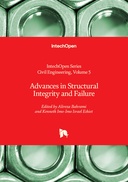Explore

Advances in Structural Integrity and Failure
0 Ungluers have
Faved this Work
Login to Fave
The purpose of this book is to expand the knowledge and skills of civil and structural engineers and researchers and help them better understand, design, and analyze civil engineering applications. This book examines advancements in structural integrity and failure and underground construction. It offers profound insights into the mechanisms that can lead to the integrity or failure of structures and result in safe underground construction. It provides details on the fundamental principles, theories, behavior, and performance of different structural elements and underground construction. The book delves into the mechanics, design, and construction of reinforced concrete structures. It explores the design principles applied to reinforced concrete structures and considers critical structural elements like beams, slabs, columns, and foundations. It also demonstrates various advances in reinforced concrete technology, including high-performance concrete, fiber-reinforced concrete, self-compacting concrete, and the use of nanomaterials. It describes methods for the analysis and evaluation of reinforced concrete structures, non-destructive testing methods, structural health monitoring, finite element analysis, and causes of failure. In addition, the book proposes a design model for determining the flexural bearing capacity of reinforced concrete beams having reinforcement steel with reduced modulus of elasticity. Moreover, the book investigates the effects of loading rates on the mechanical properties of structural steel. It also evaluates the formation of welding defects in the process of connecting steel structures, which is inevitable, from the aspect of failure mechanics. In addition, it utilizes an equivalent shell-wire model to propose a simple accurate technique for nonlinear assessment of reinforced concrete shear walls with less computational cost. The book introduces tunnel design theory and method, support structure systems, construction technology, and equipment under complex geological conditions. Furthermore, it highlights procedures to design efficient dewatering systems considering the working conditions, stability, and impacts generated in the vicinity of construction, and to examine the state of retaining walls by using hydrogeological tools. Finally, it outlines the online monitoring and intelligent diagnosis mechanism of key equipment in the subway ventilation system.
This book is included in DOAB.
Why read this book? Have your say.
You must be logged in to comment.
Rights Information
Are you the author or publisher of this work? If so, you can claim it as yours by registering as an Unglue.it rights holder.Downloads
This work has been downloaded 32 times via unglue.it ebook links.
- 32 - pdf (CC BY) at intech-files.s3.amazonaws.com.
Keywords
- buckling
- Civil engineering, surveying & building
- Crack growth
- effective strain
- Fatigue Corrosion Analysis
- Fatigue Structural Integrity
- Fracture mechanics
- multiaxial fatigue
- probabilistic analysis
- Reinforced concrete
- Risk assessment
- steel
- Structural Durability
- Structural engineering
- Technology, engineering, agriculture
Links
DOI: 10.5772/intechopen.1000457Editions

